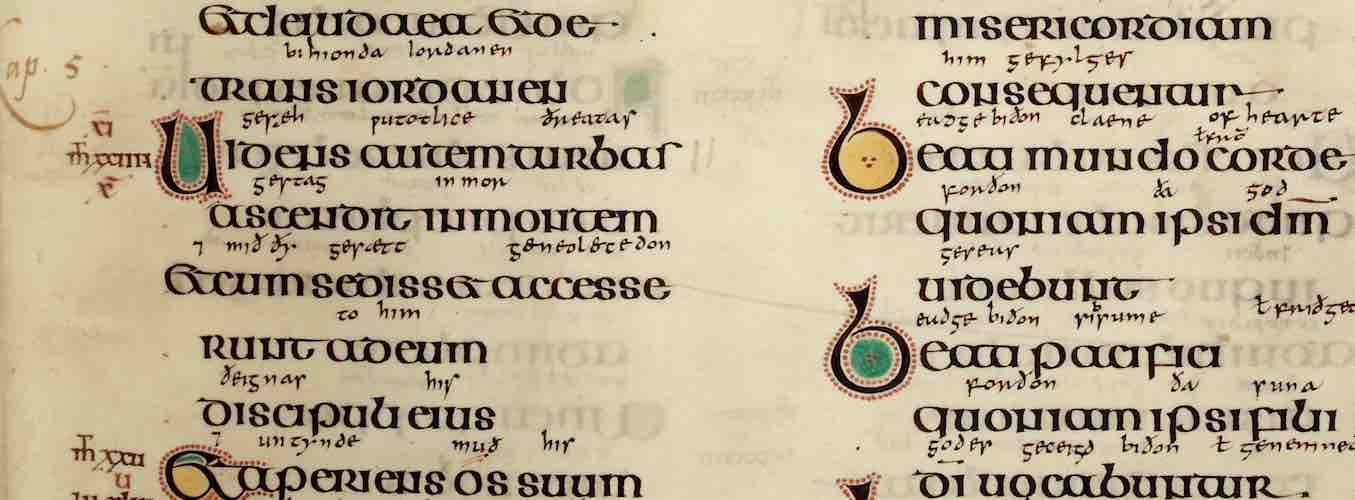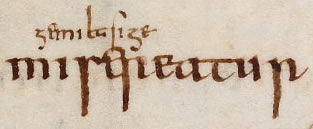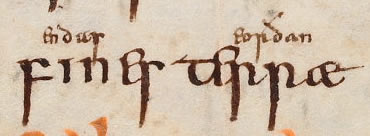Lesson
Latin Scripts - Insular

Description
Uncial used in early-medieval England, Insular Half-Uncial used in Ireland and early Anglo-Saxon England, and the minuscule scripts of Britain and Ireland. Insular developments in layout and word separation.
Overview — Insular Manuscripts
Historical Overview
“Insular” is the term used to describe the manuscript culture of Britain and Ireland in the early Middle Ages, and of monastic houses founded by the Irish and Anglo-Saxons on the Continent in the same period. The term “Insular” is sometimes restricted to the period before the Viking attacks that began in the late eighth century, when Ireland and Anglo-Saxon England developed a shared monastic and artistic culture. However, for the purposes of understanding broad categories of scripts, it is useful to understand the scripts of England and Ireland in the tenth and eleventh centuries as developments of the same pre-Viking book culture. The scripts of Britain and Ireland continue to share distinctive letterforms and abbreviations until the advent of international Gothic book culture in the high Middle Ages.
Both Ireland (with Irish parts of southwest Scotland) and England received the Latin script and the Latin language with conversion to Christianity. The scripts developed in each country reflect the range of manuscripts the Irish and English would have seen in the early decades of their acquisition of Christian culture. Ireland had not been part of the Roman empire, but was converted in the fifth century from Britain, which had a long history of Roman administration. We can deduce from later developments in Irish script and from what we know of book production and learned culture in the sub-Roman world of the fifth and sixth centuries that the Irish encountered both Christian books in Half-Uncial script, probably from the Continent, and Later Roman Cursive together with an ancient system of abbreviations, most likely directly from sub-Roman Britain. From these sources, the Irish developed a distinctive, high-grade form of Half-Uncial, as well as a minuscule bookhand that shows Half-Uncial as well as Later Roman Cursive influences. We have surviving manuscripts in these scripts beginning in the 7th century.
Irish Scripts
Irish Minuscule, ca. 700
Schaffhausen, Stadtbibliothek, Gen. 1, p. 2. (https://www.e-codices.unifr.ch/en)
Insular Half-Uncial, 8th century
St. Gallen, Stiftsbibliothek, Cod. Sang. 51, p. 8. (https://www.e-codices.unifr.ch/en)
The areas of Britain that became England, meanwhile, were settled from the fifth century by pagan Germanic tribes who, once they were settled in Britain, came to be known as the Anglo-Saxons. The Romano-British tradition of Christian Latin culture was entirely severed with the Germanic invasions, and the Anglo-Saxons had to be converted afresh. The reintroduction of Christianity to what was now Anglo-Saxon England came from two directions, with two different script traditions. Irish monks based at Iona founded monasteries across the north of England, notably at Lindisfarne, and in these places the majuscule and minuscule scripts developed by the Irish were practiced and further developed, together with a hybrid Celtic-Germanic style of decoration. At the same time, certain ecclesiastical centers in England had particularly close ties with Rome and imitated Roman Uncial books. The center of Roman influence in the south of England was Canterbury, seat of Augustine, the first Archbishop of Canterbury, who was sent by the pope to convert the Anglo-Saxons at the end of the sixth century, and his successors. In northern England at the turn of the eighth century, the abbot of the twin monastic foundation of Wearmouth and Jarrow sought out Roman models for the book arts. These Roman-influenced centers produced high-grade Uncial manuscripts in the Italian style in the 7th and early 8th centuries, while using Insular minuscule as inherited from Ireland for more ordinary books.
Insular Half-Uncial written in England, ca. 700
© The British Library Board, Cotton Nero D IV, f. 34r.
Uncials written in England, ca. 700
© The British Library Board, MS Add. 89000, f. 1r.
Broadly speaking, we can distinguish three types of scripts used in early medieval Ireland and England:
- a distinctive, high-grade form of Half-Uncial with some characteristics of Uncial, which was used in Ireland and in centers of Irish cultural influence in England
- Uncials written in England in the 7th and 8th centuries in imitation of Italian books
- a minuscule script with many of the letterforms of Half-Uncial and some distinctive letterforms and abbreviations not used elsewhere.
Latin writing in early medieval Britain and Ireland shows the effects of the fact that both the Irish and the Anglo-Saxons learned Latin from books, as an entirely foreign language. Their manuscripts consequently contain many more aids to the reader who may be struggling to comprehend a foreign language.
Insular Half-Uncial
This is the script used in the great Insular Bible manuscripts made in areas of Irish cultural influence especially in the 7th and 8th centuries, including the Lindisfarne Gospels and the Book of Kells. Insular Half-Uncial is also called Insular majuscule.
The Lindisfarne Gospels, 1st quarter of 8th century
© The British Library Board, Cotton Nero D IV, f. 34r.
The main text script is Insular Half-Uncial, with Anglo-Saxon Minuscule of a later period used for the Old English glosses between the lines.
Aspect
Insular Half-Uncial can be understood as Half-Uncial inflated to a luxury-grade majuscule script with substantial influence from Uncial. Its aspect is, accordingly, round and spacious in the manner of Uncial, although the letters intrude more into each other's space than is typical of Uncial, so the script does not quite have the lateral spaciousness of Uncial.
Characteristic letterforms
There are two groups of characteristic letterforms in Insular Half-Uncial:
- Distinctive Insular versions of Half-Uncial letters, particularly an f whose hasta sits on the baseline, and an r whose shoulder bends all the way over like the right-hand part of a lower-case n. The Insular r is very liable to confusion with p and n for the modern reader. Together with the Half-Uncial g, these letters are also used in all varieties of Insular minuscule.
- Uncial letterforms used in alternation with the dominant Half-Uncial forms of the script. These include most notably the round Uncial forms d and s alternating with the upright d and tall s of Half-Uncial, and the majuscule R alternating with the Insular r.
Details from the Lindisfarne Gospels illustrate these forms:
This line from the Lindisfarne Gospels shows the Insular f with low hasta, Uncial d, s, and R, as well as a Half-Uncial d at the end:

In this detail, there is a round Uncial s at the beginning and a tall, Half-Uncial s at the end, in ligature with u. An Uncial R in ordine contrasts with the n-shaped r in primus:

This detail shows the Half-Uncial/Insular g and a as well as the use of two different styles of N/n in the same word:

These details also show clearly how the predominantly Half-Uncial letterforms have been treated as a majuscule script, in which the letters are overwhelmingly the same height as each other, contained between two imaginary lines.
Uncial in Anglo-Saxon England
Centers in Anglo-Saxon England that received Christian book culture directly from Rome, rather than filtered through Irish missionaries, imitated the high-grade Christian books in Uncials that the Roman missionaries brought with them. The books these Anglo-Saxons used as models would have resembled the sixth-century Italian Uncial manuscripts we looked at in the Christian Late Antiquity unit, like these, both written around the year 600:
Uncials written in Italy, ca. 600
© Bibliotheca Apostolica Vaticana, Pal. lat. 210, f. 4r
Uncials written in Italy, ca. 600
The Bodleian Libraries, The University of Oxford, Auct. D. 2. 14, f. 130r.
In imitation of these Italian books, Anglo-Saxon scribes created Uncial Gospel books which in some cases so closely resemble their models that they were mistaken for Italian books well into the modern era. This one, the St. Cuthbert Gospel, was written at the end of the 7th century, probably in Wearmouth-Jarrow, the Roman-oriented center on the northeastern coast of England:
Northumbria, 698 CE
© The British Library Board, MS Add. 89000, f. 1r.
All the guidelines for identifying and dating Uncials that we studied in the unit on Christian Late Antiquity apply to Uncial manuscripts created in England. The telltale difference is that manuscripts written in England have much more advanced word separation.
Insular Minuscules
The class of Insular script with the longest history, the widest range of uses, and the most varieties, is Insular minuscule. Insular minuscule developed in the seventh century in Ireland and over the succeeding centuries was taken over by the Anglo-Saxons for books below the grade of the great luxury biblical and liturgical books that were written in Uncial or Insular Half-Uncial. Insular minuscule was used in Ireland for both Latin and Irish-language texts until the end of the Middle Ages. In England, it was used for both Latin and Old English texts through the early tenth century, and thereafter for the vernacular only, until the Norman Conquest.
This manuscript of the Life of St. Columba by Adomnan was written around the year 700 in Iona, the center from which Irish monastic culture was spread to England in the seventh and eighth centuries. It exemplifies the early Irish version of Insular minuscule.
Written in Iona between 688 and 713
Schaffhausen, Stadtbibliothek, Gen. 1, p. 2. (https://www.e-codices.unifr.ch/en)
The alphabet is recognizably a descendant of late-antique Half-Uncial and shares the typical Insular letterforms we saw in Insular Half-Uncial. Note the d with upright ascender and bow not quite closed, so it might be mistaken for cl, and the minuscule forms of n and a. The g is the same Half-Uncial form seen both in early Half-Uncials and in the majuscule form of Half-Uncial used in the great Insular Bible manuscripts like Lindisfarne. Note the f with low-shouldered hasta and the r whose shoulder bends almost down to the baseline, so that it resembles an n.



Note also the wedge-shaped finials on upright strokes, especially of d, p, and r. These wedges are typical of both Insular majuscule and Insular minuscule. In succeeding centuries in both England and Ireland, this script became more clearly minuscule and developed a pointed aspect, as both ascenders and descenders grew longer. Notably, f, r, and s acquired long, pointed descenders.
This manuscript is a Psalter with Old English glosses from the second quarter of the tenth century. An Anglo-Saxon form of Insular minuscule is used both for the main text, in Latin, and in a smaller version for the vernacular glosses between the lines. If you cast your eye over the page, you will see many long, spiky descenders hanging down from each line. These are the fs, rs, and ss.
Anglo-Saxon Minuscule, first quarter of the 10th century
The Bodleian Libraries, The University of Oxford, Junius 27, f. 66r.
Because of its exaggerated descenders and finer penwork, this script may seem far removed from that of the Iona manuscript of more than two centuries earlier. If you look at the letterforms, however, you will see the persistence of the typical Insular forms.
In these details, we can compare Insular r and s. The s basically has the same form as Half-Uncial tall s, but instead of sitting on the baseline, it has a long descender and its shoulder stays at minim-height. The r has the same long descender, but its shoulder bends over and comes all the way down to the baseline, so that without its descender it would resemble an n:


The f also has a long descender, as in Insular Half-Uncial, with the low cross-bar. This detail shows f, s, and r in close proximity:

The details above shows how a grouping of long-tailed fs, rs, and ss, plus other letters with descenders like p, contribute to the vertical and somewhat spiky aspect of a page of developed Insular minuscule.
Language on the Page in Insular Manuscripts
Layout and Legibility
High-grade Insular manuscripts took over the layout patterns of their late-antique models. This meant a fairly spare, spacious page with margins largely free of writing on the text pages; a general preference for single-column layouts for smaller books and two-column layouts for large, luxury Bible manuscripts. These features of late-antique Uncial manuscripts were imitated both in Uncial manuscripts made in Romanizing centers in Anglo-Saxon England, and in Irish and Irish-influenced centers that used Insular Half-Uncial.
Compare the layout of the Lindisfarne Gospels with one of the Italian Uncial manuscripts of a century earlier that we looked at in the last lesson:
The Lindisfarne Gospels. Northumbria, ca. 700
© The British Library Board, Cotton Nero D IV, f. 34r.
Italy, ca. 600
The Bodleian Libraries, The University of Oxford, Auct. D. 2. 14, f. 130r.
Compare, too, the single-column layout in a mid-8th-century Irish Gospel book with a 6th-century Italian manuscript of Augustine:
Ireland, 8th century
St. Gallen, Stiftsbibliothek, Cod. Sang. 51, p. 8. (https://www.e-codices.unifr.ch/en)
Italy, ca. 600
© Bibliotheca Apostolica Vaticana, Pal. lat. 210, f. 4r
The Insular scribes have taken over the late-antique tools to aid legibility. In the Lindisfarne Gospels, as in late-antique Italian models, the text is laid out per cola et commata — Jerome’s system of writing one sense unit to a line. In the single-column Irish book, St. Gallen Cod. Sang. 51, we see a marking of the beginnings of sentences with litterae notabiliores, as in the earlier Italian book from the Vatican.
The big difference — apart from choice of script — between Insular manuscripts of the 7th and 8th centuries and Continental manuscripts of a century earlier is that Insular scribes had begun to introduce separation between words. Note in the examples above how in Biblioteca Apostolica Vaticana MS Pal. lat. 210, there are big spaces between sentences but no spaces at all between words. That indicates a readership that might have been interested in help navigating the text as a whole, but had little need of visual help identifying where words started and ended. 6th-century Italian readers spoke a form of Late Latin close enough to the language of Augustine or Jerome that their native-speaker intuitions would have been useful in navigating the written form of their language. Irish and Anglo-Saxon readers, on the other hand, needed all the help they could get with Latin, a completely foreign language. In St. Gallen Cod. Sang. 51, the Irish manuscript, there is fairly consistent spacing between words. The introduction of word spacing was an innovation of Insular scribes in this period.
What Happens Next?
Insular minuscule continues to be used in Ireland for the rest of the Middle Ages. In England from the end of the tenth century, Insular minuscule comes to be restricted to the vernacular only. Once contact is reestablished with Continental centers after the period of Viking raids, English scribes begin to use Caroline Minuscule for Latin texts. (We will look at Caroline Minuscule in the next unit.) We have many manuscripts from later Anglo-Saxon England (from around the 970s to the end of the 11th C.) with Latin texts in Caroline Minuscule accompanied by Old English texts in Insular Minuscule. Similarly, Irish scribes who went to the Continent continued to use Insular minuscule for Old Irish glosses in manuscripts whose main Latin texts were written in Caroline Minuscule.
Although peculiarly Insular scripts fade as scribal culture increasingly becomes Europe-wide from the Carolingian period on, the innovations of Insular scribes in layout, word separation, punctuation, abbreviation, and other paratextual features were extremely influential in the scribal practice on the Continent in subsequent centuries.
If you read Latin, go to the Insular Scripts Transcription lesson to try transcribing Insular Half-Uncial and Insular Minuscule. Otherwise, go directly to the Carolingian Paleography lesson.
Ready to transcribe?
Try your hand at transcribing Insular Manuscripts scripts